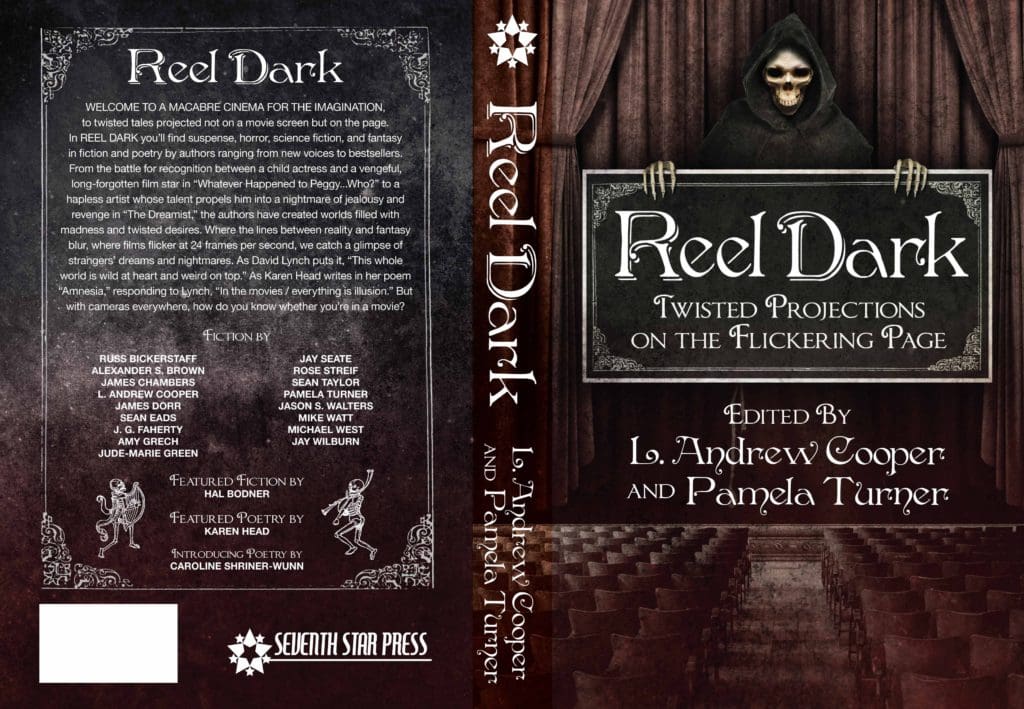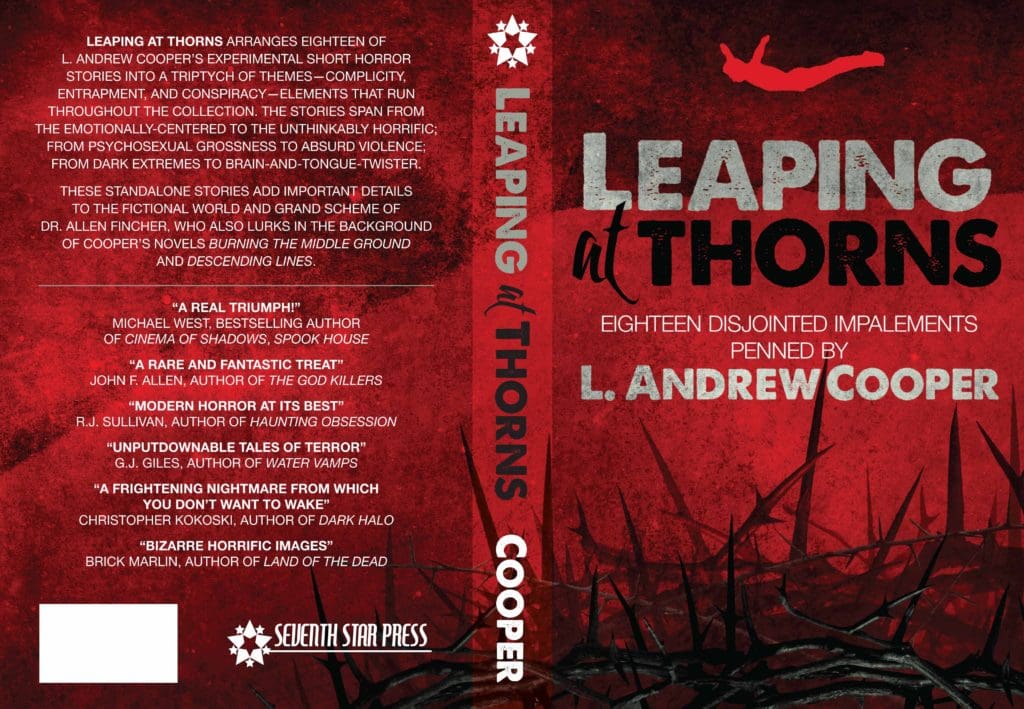Extreme, often intimate stories–horrific, bizarre, scary, offensive, funny, absurd, disturbing, or just plain WTF–in turns or all at the same time–when am I going to produce a by-the-rules book that will lure in readers by targeting their comfort zones with words that don’t explode? Not any time soon…
As I write this post, the first goal of which is to show off amazing cover art by Aaron Drown Design, I am getting ready to travel to Las Vegas for StokerCon, the Horror Writers’ Association’s major convention, where I will see print copies of my new short story collection Peritoneum as well as new editions of Leaping at Thorns and Reel Dark for the first time. (For more about the new Reel Dark, see “REEL DARK in the Spotlight,” and for even more about Peritoneum, see “Inside the Peritoneum.”)
As I’ve already posted, Reel Dark has new stories by Michael West and Alexander S. Brown, and since the book’s first edition had very limited exposure, all of it is new to almost everyone, so I’m excited about it. The collection of award-winning authors as well as newer voices spinning tales of movie mayhem is destined to please lovers of dark fiction. Yes, I’ve got a story in it, but unlike the other two books I’m talking about here, this one ain’t about me. I’m showing off a collection of other people’s work, stories and poems I really like, and I’m darned proud of it.
Like the new edition of Reel Dark, the second edition of Leaping at Thorns is bigger than the first, with one tale added in each of the three sections. (Unlike Reel Dark, these stories are all me.) To the “Complicity” section I’ve added “Silence,” about a woman who keeps losing people, literally, after she has a surreal experience in an abandoned house. To “Entrapment,” I’ve added “House of Butterflies,” in which flesh does more than crawl–it flies. To “Conspiracy,” I’ve added “Kindertotenlieder,” about a twentieth-century Pied Piper whose storybook vengeance is even more horrific than the worst version you’ve read. With these additions, the book provides an even better view of the self-obliterating drive toward darkness that binds all the stories together. With the stunning new cover and support from Seventh Star Press–and with the first edition’s enthusiastic reviews–I’m looking forward to Leaping at Thorns freaking out a larger audience.
So what, then, of the newest addition to the bunch–the one with the guts on the cover and the hard-to-pronounce title, Peritoneum? It’s a different kind of animal. In a very small circle of friends I’ve been calling it a Winesburg, Ohio on acid, not because it’s about small-town life (although a significant number of stories focuses on a suburban house… especially its basement) but because the stories share characters and inform one another. In fact, although I published a few stories separately, and a few stories only relate to the whole tangentially, I wrote the vast majority of these tales to stand alongside the other tales. That design makes this book very different from Leaping at Thorns, which has some interrelated stories that nevertheless stand alone. In Peritoneum, I hope you’ll enjoy reading stories individually, but you’ll get a lot more out of them if you read them together. The volume starts with “The Family Pet” and “Blood and Feathers” because they introduce elements that run throughout the book, and it ends with “The Birds of St. Francis” and “The Broom Closet Where Everything Dies” because they tie a lot of those elements together.
Don’t let me mislead you. I don’t promise that the stories make sense when you read them all together. Sure, they make more sense. Some of the WTFs in “The Eternal Recurrence of Suburban Abortion” get answered in the next tale, “TR4B,” and even the comical scenario of “DNA” gets backstory work in “The Broom Closet Where Everything Dies.” HOWEVER–my goal is to offer little eddies of revelation in a greater sea of insanity, where sense and reason fail more often than they succeed. Lots of horror stories have endings that explain the horrors and box them away. Many of them are good. Few of them scare me.
What scares me is the breakdown of sense, the failure of perception. As a result, my stories and the perceptions inside of them tend to break down. Sometimes, I couch the breakdown overtly in terms of the supernatural and/or mental illness and/or drugs (especially in “Patrick’s Luck,” “The Road Thief,” “The Long Flight of Charlotte Radcliffe,” and “Door Poison”), and sometimes I just let them unwind by their own devices. My hope is that the stories, while not always conventionally satisfying, will disturb you on some level–move you to feel afraid, amused, bewildered, and so on–and result in entertainment, albeit of a brooding and uncomfortable sort.
Oh, I worry about things. “Blood and Feathers” has two endings, neither of which is a resolution… “Year of the Wolf” pivots around quotes from an obscure World War Two documentary as well as a scientific curiosity… “Juicy the Liar” opens with a line about eating pussy… I thought of “Bubble Girl” as YA until readers started seeing all kinds of crazy sex stuff in it that I thought was buried well under the surface… “The Broom Closet” goes beyond nasty… much could go wrong in the reading of Peritoneum. But without that possibility, I’m not sure it could really go right, either.




Comments are closed.